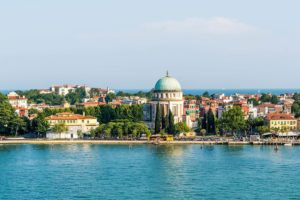Murazzi

The Murazzi (Italianisation of "murassi", or large walls) constitute a long defensive breakwater in white Istrian stone, fixed on layers of pebbles and large stilts 4.5 meters high above sea level.
They are considered the last construction of the Republic of Venice before its fall, and were designed to contain the action of the sea, having replaced other previous defensive systems that were insufficient to contain its fury. Indeed, initially there were stilts reinforced with stones and sand, followed by the so-called “palàe”, rows of wooden beams.
The walls are divided into three sections: that of the Lido, five kilometers long, between Ca’ Bianca and Alberoni, that of Pellestrina, 10 kilometers long, between Santa Maria del Mare and Ca’ Roman, and that of Sottomarina, 1225 meters long.
The walls were imagined by a cosmographer and engineer of the Serenissima, Vincenzo Maria Coronelli, who thought of the stone for the fortification, and Bernardo Zendrini, a hydraulic engineer, took care of their construction, which began in April 1744 and continued throughout the eighteenth century.
Over time, the walls were damaged by repeated coastal storms and yielded in 1966, causing the flood that submerged Venice (as outlined in the Piccolo Museo [Small Museum] of the South Lagoon, in San Pietro in Volta di Pellestrina).
Today they have been reinforced by further consolidation, and the most striking part of this long fortification is the stretch between the cemetery of Pellestrina and Ca’ Roman, the thinnest strip of land on the island: here the sea and the lagoon are separated only by the breakwater, and you literally walk in the middle of the water.












